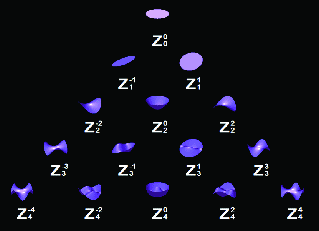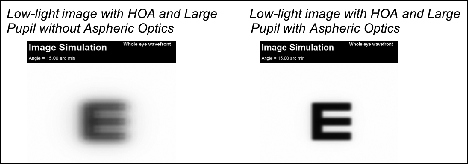Contact Lens Correction of Spherical Aberrations
Providing patients with the best possible vision
requires wavefront knowledge and advanced lens technology.
By Paul Karpecki, OD
It's safe to say that the ultimate goal of most eyecare practitioners is to provide superior visual quality to their patients. This goal has become easier to achieve, thanks to relatively recent advancements in the technology (wavefront aberrometers, pachymetry systems and corneal topographers, etc.) that measures subtle irregularities across the ocular system to generate meaningful data for each specific patient. The data gathered from these various tools allow eyecare professionals to better fit the respective patients with precision-design contact lenses that can correct not only the most common refractive errors (myopia, hyperopia and astigmatism), but also may correct higher-order aberrations (HOAs).
Defining Aberrations
Generally speaking, a patient perceives a visual aberration as a blurring or halo effect, particularly in low contrast situations. It may result from a natural defect in the optical system of the eye (inherent), or it may be introduced (induced) by a vision correction system (such as spectacles, contact lenses or surgery) or both.
Standard Zernike Modes
Figure 1 shows the work by Dr. David Williams and colleagues at the University of Rochester that illustrates how individual Zernike Polynomials could be presented as waveforms. Eyecare professionals primarily direct their attention toward second-order aberrations, which include spherical refractive error (also referred to as "defocus") and astigmatism. Then come third-order aberrations, of which coma (from the Italian word for comet) is the most important. Next come fourth-order aberrations that primarily include spherical aberration.
What Should You Correct First — Higher- or Lower-order Aberrations? It's important to note that you must correct the lower-order aberrations of defocus and astigmatism before the correction of any HOAs can have a substantial effect. This is the rationale for correcting defocus and astigmatism first.
For instance, using an aspheric lens to correct astigmatism has limited impact compared to prescribing a toric lens because the distortion caused by the second-order aberration (astigmatism) is of a greater magnitude than the HOAs. However, a toric contact lens that has an aspheric design component (such as the PureVision Toric [Bausch & Lomb]) corrects the astigmatism and may correct the higher-order spherical aberrations as well.
Understanding this subtle nuance may enable you to provide your patients with more precise treatment options that result in better visual quality and better outcomes in general.
Causes of Visual Aberrations

|
|
Figure 1. Zernike polynomials presented as individual wave forms. |
To understand what causes visual aberrations, recall how a wave of light changes as it passes through various media (such as a contact lens, which induces aberrations; or the physiological structures of the eye, which are responsible for inherent aberrations in the ocular system) and is directed toward a specific focal plane. Once the bundle of light rays encounters a change in refractive index (something other than air such as the cornea, lens and/or fluid in the eye), this affects the direction of light (wave/rays) passing through the media and the impeded light rays fail to reach a common focal point on the retina. The impeded light indicates some type of aberration within the ocular system.
In a hypothetically "perfect eye," the wavefront of light from the object would have an ideal, uniform shape after passing through the ocular system. The ideal wavefront is indicated by the uniform spot array and corresponding uniform geometric design that the spot array pattern generates. In the "ideal world," this wavefront would converge to a focal point on the desired focal plane. While that would be the ideal, there are no perfect eyes and so the "real world" isn't representative of the "ideal world." Figure 2 shows how an aberrometer measures the wavefronts of the eye and how the spot array pattern might appear for an aberrated eye.
Night Myopia = Spherical Aberration
As the pupil enlarges, more peripheral light rays enter into the visual system and bend in front of the retina, creating a myopic condition. This visual effect is most pronounced in low-light environments and is relatively undetectable under well-illuminated conditions.
For years we called this phenomenon "night myopia," but we now know it's simply the manifestation of higher-order spherical aberration.

|
|
Figure 2. An aberrated eye does not produce a uniform spot array pattern when measured by an aberrometer. Image courtesy of Steven Linn, OD. |
With a best spectacle correction in place, it's hard to see any wave aberration effects for a pupil smaller than 3mm. However, as the pupil diameter increases larger than 3mm, you can begin to see possible gains resulting from minimizing the wave aberration of the normal eye.
Figure 3 shows an image simulation of a convoluted "E" that represents the effects of spherical aberration and its correction using aspheric optics. However, not all patients will perceive this dramatic a difference in their visual quality with aspheric optics. The amount of "night myopia" differs among individuals. On average, it's about 0.50D, but some patients may have as much as 1.25D of night myopia. Although its effects are subtle, details around streetlights and automobile headlights are blurred. The aspheric optics of the PureVision contact lens can help improve such quality of vision by increasing contrast sensitivity and image crispness in a majority of patients.
Correcting Spherical Aberration With Contact Lenses
In designing contact lenses that reduce aberrations of the visual system, many factors must be considered — including the typical aberrations of a normal population. For spherical surface lenses, rays may be parallel to the optic axis but at different distances from the optic axis, and thus fail to converge to the same point. Spherical aberrations occur when light waves passing through the periphery of a lens don't come into focus with those passing through the lens center. Waves passing near the center of the lens are refracted only slightly, whereas waves passing near the periphery are refracted to a greater degree, producing a variety of different focal points along the optical axis.
According to B&L, PureVision is the only contact lens on the market that combines next-generation aspheric optics with silicone hydrogel technology. The ability to reduce or eliminate the spherical aberration (Z40) with specially designed optics is an effective application of wavefront technology.
One of the potential benefits from the PureVision lens that we've observed in practice is patients commenting on the quality of vision, particularly at night, with the lens, which may result from the correction of higher-order spherical aberration.

|
| Figure 3. Comparison of 0.1 microns of spherical aberration (over 6mm). |
Conclusion
If we want to provide patients with the best possible
quality of vision, then we need to better understand the role that HOAs play within
the ocular system —otherwise our patients may experience sub-optimal results.
The fact of the matter is that we'll continue to see rapid advancements in wavefront
technology related to HOA, and it will become increasingly more important for eyecare
professionals to be aware of those HOA advancements so we can incorporate the latest
learning and principles into our respective practices — thereby benefiting
our patients. CLS
Dr. Karpecki is Director of Research at
Moyes Eye Center in Kansas City and is a consultant to Bausch & Lomb.



